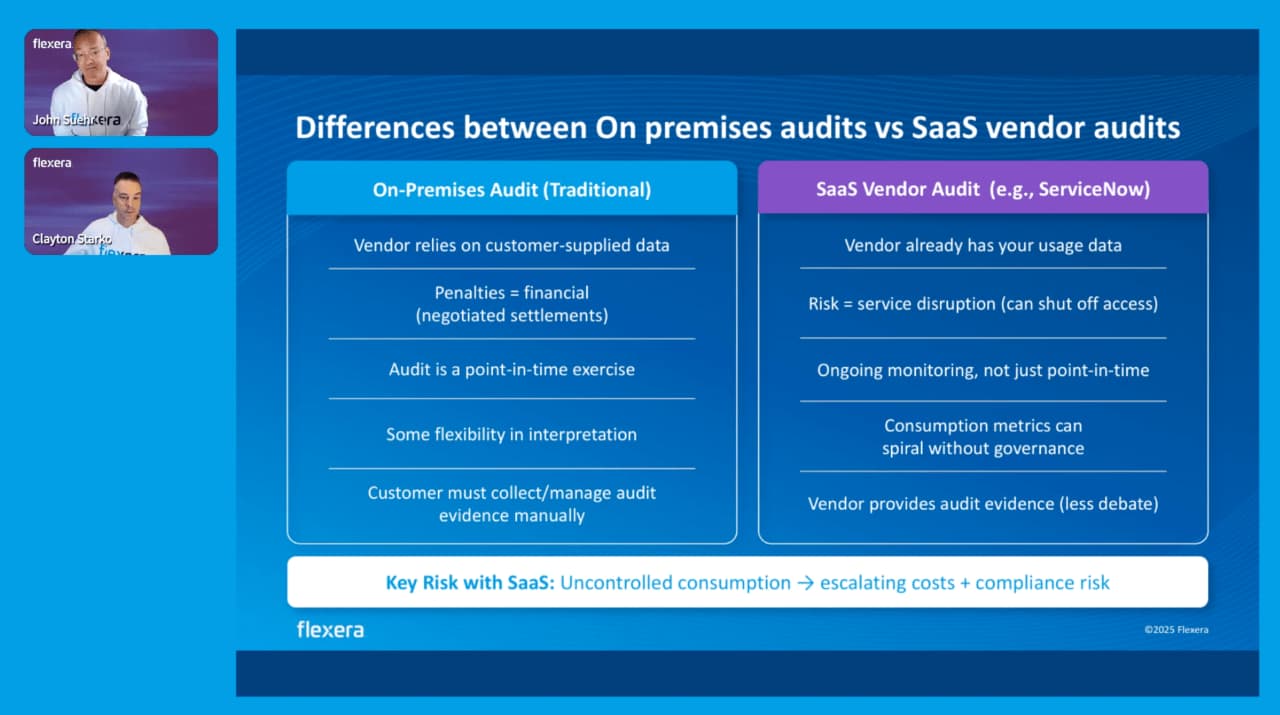Overview
Want to keep ServiceNow costs under control and stay ready for audits? Flexera experts Clayton Starko and John Suehr explain licensing models, and share compliance best practices. Learn optimization strategies, explore AI trends and get governance tips to help you maximize value. Watch now to take charge of your ServiceNow license position.
Recap: ServiceNow licensing best practices
SaaS audit landscape: What’s changed in the SaaS era
- SaaS vendors audit too. According to the 2025 State of ITAM Report, over 20% of surveyed companies have faced a ServiceNow audit in the past three years.
- SaaS vendors can see usage: Unlike on-premises software, SaaS providers can see usage directly in their cloud, reducing debate over evidence and shifting leverage.
- Contract terms matter: may include up to two audits per year, negotiated timing, and true-up periods; repeated overages can lead to service disruption.
- Continuous monitoring vs point-in-time: SaaS pushes ongoing consumption oversight; uncontrolled usage leads to escalating cost and compliance risk.
ServiceNow licensing models explained (and where compliance risk hides)
- Traditional: user-based licenses with roles like requester, business stakeholder/approver, fulfiller (paid component for ITSM). Rights-based vs unrestricted: Unrestricted licenses (easier to manage, often discounted) vs rights-based (assign exactly what each user needs)—a strategic choice visible in Subscription Management.
- Capacity-based licensing: pooled entitlements (e.g., Integration Hub, SecOps, ITOM/AIOps, ServiceNow Assist transactions). Storage overages are increasingly relevant to watch.
- Reality = hybrid: Many organizations mix user-based for fulfillers/approvers with unrestricted or capacity models for broad access (e.g., HR portal).
License types
| License Type | Description | Management Considerations | Risks | License Type |
|---|---|---|---|---|
| User License | Based on named users assigned roles | Track actual usage vs. assigned roles; avoid over-allocation | Overlapping subscriptions, unused roles | User License |
| Role-Based License | Tied to packaged app entitlements and specific roles within ServiceNow | Validate role assignments; monitor direct vs. group-based roles | Blind spots in Subscription Management V2 | Role-Based License |
| Application License | Licensed per ServiceNow application (e.g., ITSM, CSM) | Monitor application usage; reconcile against purchases | Misalignment between usage and entitlements | Application License |
| Consumption License | Based on volume of Integration Hub, API calls and storage consumption API calls | Track integration hub usage and storage consumption | Hidden charges and audit exposure | Consumption License |
GenAI in ServiceNow: adoption, data readiness and cost management
- GenAI Licensing: ServiceNow’s GenAI features use a token-based model (Assist, Skill, Action). Usage and costs depend on the complexity of tasks.
- AI Evolution: ServiceNow has progressed from scripted workflows to agentic AI, enabling more autonomous operations.
- Governance & Data: Effective GenAI adoption requires strong governance and clean, reliable data to ensure accurate outputs and control costs.
- Industry Adoption: Most organizations are adopting or planning to adopt GenAI, but readiness and cost management are key concerns.
- Flexera’s Role: Flexera is developing AI-driven tools to automate contract analysis and optimize ServiceNow licensing.
How to prepare for GenAI in ServiceNow
- Know GenAI Licensing: Understand ServiceNow’s GenAI constructs to forecast usage and costs.
- Govern Usage: Implement governance to monitor consumption and avoid surprises.
- Optimize Continuously: Use tools to automate license management and identify savings.
ServiceNow Compliance Data Foundations: Roles, Groups and Reporting
- Subscription → Application → Role → Role Type chain drives who is counted; e.g., fulfiller is the paid component in ITSM, while requester may be free.
- Subscription Management vs Use Verification Report (UVR):
- UVR used for audits; excludes users inactive >365 days and service/web-service accounts from chargeable use (fairness rules).
- Subscription Management may appear over-consumed because it lacks those exclusions.
- Blind spot to fix: Direct role assignments outside Groups aren’t visible to Subscription Management; UVR will catch them—so reconcile both views.
- Group-first governance: Defining groups and approvers provides instant controls and makes optimization/reporting repeatable (even if migration from direct roles is effortful).
Five ways ITAM and ITSM teams can optimize ServiceNow licensing
- Find overlapping subscriptions: Many subscriptions grant access to the same capabilities/apps; decide which subscription each user should “count against” to use purchased capacity before buying more.
- Choose by availability or cost: For example, you can assign some users who overlap to ITSM Pro where you have more room, and the rest to CSM Pro. You can also choose the SKU that costs the least.
- Downgrade under-used fulfillers: If a fulfiller has no rights activity in 90 days (UA app usage), consider a requester or cheaper role—without impacting productivity. Trend usage before acting.
- Attack “phantom” consumption: Sort by last login (e.g., >300/365/90 days) and reclaim; UVR won’t charge for >365-day inactive and service accounts, but reclaiming frees headroom.
- Monitor storage/capacity: Customers report storage overages increasing—track growth, dedupe opportunities and set alerts for thresholds.
Audit-readiness = renewal readiness (how to stay ahead)
- Trust but verify: Use third-party views to reproduce UVR, correlate with Subscription Management and justify negotiations with underlying evidence.
- Forecast with history: Two years of license and usage history enables linear or seasonal regression forecasting; incorporate joiners/leavers and business events to rightsize renewals.
- Policy & AI governance: With agentic features expanding, define guardrails (who can invoke which Skills/Actions, quotas, review points) to prevent consumption spikes and compliance issues.
Speakers

Clayton Starko
Director, Solutions Architecture & Advisory, Flexera
With over 25 years of hands-on IT experience, Clayton leads Flexera’s Solutions Architecture team, specializing in ITAM and ServiceNow optimization.

John Suehr
Solutions Architect, Flexera
John is a Solution Architect with deep practical expertise in SaaS license management, helping organizations streamline software usage and maximize ROI.
Frequently asked questions
ServiceNow uses user‑based licenses (e.g., fulfiller, approver, requester) and capacity‑based metrics (e.g., Assist transactions, Integration Hub). Many organizations use a hybrid of both, requiring careful tracking of assignments and usage.
Requesters typically have free access, stakeholders approve items and fulfillers are paid users. Mapping subscriptions to roles and measured types determines audit counts.
Rights‑based models assign licenses to specific users, offering control but needing management. Unrestricted models cover broad user groups and are easier to manage but less precise.
These models use pooled entitlements consumed by actions or workflows. Usage can spike with automation, so monitoring is key to avoid overages.
Subscription Management shows license allocations and compliance views/report and the Use Verification Report shows user activity views. Differences between them must be reconciled.
Users inactive for over 365 days and service accounts are usually excluded from audits. However, they may still appear in Subscription Management, requiring reconciliation.
Groups offer scalable assignment, governance and better reporting. Though setup takes effort, it simplifies optimization and audit readiness.
Clean operational data and trend analysis are essential to ensure accurate AI outputs and control consumption. Poor data increases governance challenges and costs.
Once permissions are set and the connector runs, data is usually available within 24 hours. Most delays come from setting up service accounts.
Flexera identifies users counted in multiple subscriptions and suggests optimal assignments. It prioritizes available or lower-cost entitlements to avoid overspending.
By analyzing 90-day usage data, Flexera spots fulfillers with minimal activity who can be reassigned to cheaper roles. This supports controlled license optimization.
Flexera doesn't change roles directly but shows current roles, usage and governance gaps. Teams can use this data to apply corrections via existing workflows.
SaaS vendors monitor usage continuously, so audit and renewal data are the same. Use UVR alignment, cleanup and forecasts to prepare for renewals confidently.
Let’s get started
Our team is standing by to discuss your requirements and deliver a demo of our industry-leading platform.

